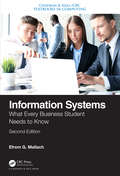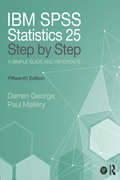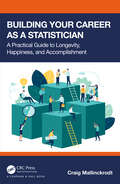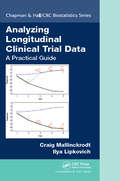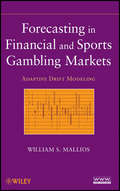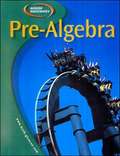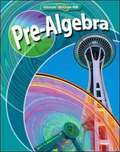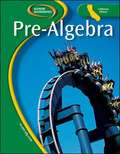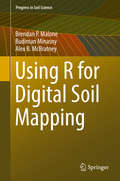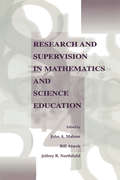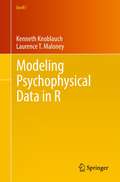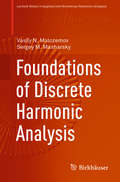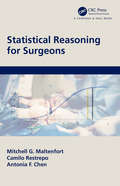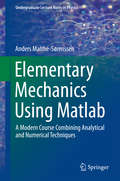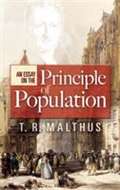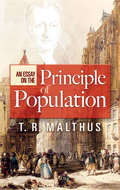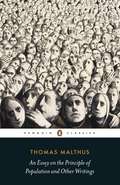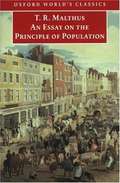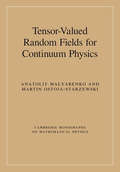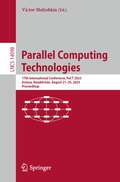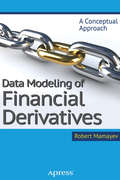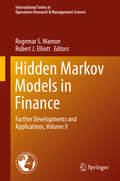- Table View
- List View
Information Systems: What Every Business Student Needs to Know, Second Edition (Chapman & Hall/CRC Textbooks in Computing)
by Efrem G. MallachMost information systems textbooks overwhelm business students with overly technical information they may not need in their careers. This textbook takes a new approach to the required information systems course for business majors. For each topic covered, the text highlights key "Take-Aways" that alert students to material they will need to remember during their careers. Sections titled "Where You Fit In" and "Why This Chapter Matters" explain how the topics being covered will impact students on the job. Review questions, discussion questions, and summaries are also included. This second edition is updated to include new technology, along with a new running case study. Key features: Single-mindedly for business students who are not technical specialists Doesn&’t try to prepare IS professionals; other courses will do that Stresses the enabling technologies and application areas that matter the most today Based on the author&’s real-world experience Up to date regarding technology and tomorrow&’s business needs This is the book the author—and, more importantly, his students—wishes he had when he started teaching. Dr. Mallach holds degrees in engineering from Princeton and MIT, and in business from Boston University. He worked in the computer industry for two decades, as Director of Strategic Planning for a major computer firm and as co-founder/CEO of a computer marketing consulting firm. He taught information systems in the University of Massachusetts (Lowell and Dartmouth) business schools for 18 years, then at Rhode Island College following his retirement. He consults in industry and serves as Webmaster for his community, in between hiking and travel with his wife.
IBM SPSS Statistics 25 Step by Step: A Simple Guide and Reference
by Paul Mallery Darren GeorgeIBM SPSS Statistics 25 Step by Step: A Simple Guide and Reference, fifteenth edition, takes a straightforward, step-by-step approach that makes SPSS software clear to beginners and experienced researchers alike. Extensive use of four-color screen shots, clear writing, and step-by-step boxes guide readers through the program. Exercises at the end of each chapter support students by providing additional opportunities to practice using SPSS. This book covers both the basics of descriptive statistical analysis using SPSS through to more advanced topics such as multiple regression, multidimensional scaling and MANOVA, including instructions for Windows and Mac. This makes it ideal for both undergraduate statistics courses and for postgraduates looking to further develop their statistics and SPSS knowledge. New to this edition: Updated throughout to SPSS 25 Updated / restructured material on: Chart Builder; Univariate ANOVA; moderation on two- and three-way ANOVA; and Factor Analytic Techniques (formerly Factor Analysis structure) New material on computing z and T scores, and on computing z scores within descriptive statistics Clearer in-chapter links between the type of data and type of research question that the procedure can answer Updated / additional datasets, exercises, and expanded Companion Website material, including Powerpoint slides for instructors
Statistical Learning for Biomedical Data
by James D. Malley Karen G. Malley Sinisa PajevicThis book is for anyone who has biomedical data and needs to identify variables that predict an outcome, for two-group outcomes such as tumor/not-tumor, survival/death, or response from treatment. Statistical learning machines are ideally suited to these types of prediction problems, especially if the variables being studied may not meet the assumptions of traditional techniques. Learning machines come from the world of probability and computer science but are not yet widely used in biomedical research. This introduction brings learning machine techniques to the biomedical world in an accessible way, explaining the underlying principles in nontechnical language and using extensive examples and figures. The authors connect these new methods to familiar techniques by showing how to use the learning machine models to generate smaller, more easily interpretable traditional models. Coverage includes single decision trees, multiple-tree techniques such as Random Forests(TM), neural nets, support vector machines, nearest neighbors and boosting.
Building Your Career as a Statistician: A Practical Guide to Longevity, Happiness, and Accomplishment
by Craig MallinckrodtThis book is intended for anyone who is considering a career in statistics or a related field, or those at any point in their career with sufficient work time remaining such that investing in additional learning could be beneficial. As such, the book would be suitable for anyone pursing an MS or PhD in statistics or those already working in statistics. The book focuses on the non-statistical aspects of being a statistician that are crucial for success. These factors include 1) productivity and prioritization, 2) innovation and creativity, 3) communication, 4) critical thinking and decisions under uncertainty, 5) influence and leadership, 6) working relationships, and 7) career planning and continued learning. Each of these chapters includes sections on foundational principles and a section on putting those principles into practice. Connections between these individual skills are emphasized such that the reader can appreciate how the skills build upon each other leading to a whole that is greater than the sum of its parts. By including the individual perspectives from other experts on the fundamental principles and their application, readers will have a well-rounded view on how to build upon and fully leverage their technical skills in statistics. The primary audience for the book is large and diverse. It will be useful for self-study by virtually any statistician, but could also be used as a text in a graduate program that includes a course on careers and career development.Key Features: Takes principles proven to be useful in other settings and applies them to statisticians and statistical settings. Focused Concise Accessible to all levels, from grad students to mid-later career statisticians.
Analyzing Longitudinal Clinical Trial Data: A Practical Guide (Chapman & Hall/CRC Biostatistics Series)
by Craig Mallinckrodt Ilya LipkovichAnalyzing Longitudinal Clinical Trial Data: A Practical Guide provides practical and easy to implement approaches for bringing the latest theory on analysis of longitudinal clinical trial data into routine practice.The book, with its example-oriented approach that includes numerous SAS and R code fragments, is an essential resource for statisticians and graduate students specializing in medical research. The authors provide clear descriptions of the relevant statistical theory and illustrate practical considerations for modeling longitudinal data. Topics covered include choice of endpoint and statistical test; modeling means and the correlations between repeated measurements; accounting for covariates; modeling categorical data; model verification; methods for incomplete (missing) data that includes the latest developments in sensitivity analyses, along with approaches for and issues in choosing estimands; and means for preventing missing data. Each chapter stands alone in its coverage of a topic. The concluding chapters provide detailed advice on how to integrate these independent topics into an over-arching study development process and statistical analysis plan.
Forecasting in Financial and Sports Gambling Markets
by William S. MalliosA guide to modeling analyses for financial and sports gambling markets, with a focus on major current eventsAddressing the highly competitive and risky environments of current-day financial and sports gambling markets, Forecasting in Financial and Sports Gambling Markets details the dynamic process of constructing effective forecasting rules based on both graphical patterns and adaptive drift modeling (ADM) of cointegrated time series. The book uniquely identifies periods of inefficiency that these markets oscillate through and develops profitable forecasting models that capitalize on irrational behavior exhibited during these periods.Providing valuable insights based on the author's firsthand experience, this book utilizes simple, yet unique, candlestick charts to identify optimal time periods in financial markets and optimal games in sports gambling markets for which forecasting models are likely to provide profitable trading and wagering outcomes. Featuring detailed examples that utilize actual data, the book addresses various topics that promote financial and mathematical literacy, including:Higher order ARMA processes in financial marketsThe effects of gambling shocks in sports gambling marketsCointegrated time series with model driftModeling volatilityThroughout the book, interesting real-world applications are presented, and numerous graphical procedures illustrate favorable trading and betting opportunities, which are accompanied by mathematical developments in adaptive model forecasting and risk assessment. A related web site features updated reviews in sports and financial forecasting and various links on the topic.Forecasting in Financial and Sports Gambling Markets is an excellent book for courses on financial economics and time series analysis at the upper-undergraduate and graduate levels. The book is also a valuable reference for researchers and practitioners working in the areas of retail markets, quant funds, hedge funds, and time series. Also, anyone with a general interest in learning about how to profit from the financial and sports gambling markets will find this book to be a valuable resource.
Glencoe Mathematics: Pre-algebra
by Carol Malloy Jack Price Teri WillardThis Glencoe Mathematic Pre-Algebra textbook contains lessons on Algebra and Integers, Algebra and Rational Numbers, Linear Equations, Inequalities, and Functions, Applying Algebra to Geometry, Extending Algebra to Statistics and Polynomials in an easy to learn way.
Pre-Algebra
by Malloy Molix-Bailey Price WillardTHE PROGRAM STUDENTS NEED; THE FOCUS TEACHERS WANT! "Glencoe Pre-Algebra" is a key program in our vertically aligned high school mathematics series developed to help all students achieve a better understanding of mathematics and improve their mathematics scores on today's high-stakes assessments.
Glencoe Mathematics: Pre-Algebra
by Malloy Price WillardA new way of thinking about Algebra readiness! Focused, organized, and easy to follow, Glencoe Pre-Algebra shows your students how to read, write, and understand the unique language of mathematics, so they'll be prepared for every type of problem-solving and assessment situation.
Using R for Digital Soil Mapping
by Brendan P. Malone Budiman Minasny Alex B. McbratneyThis book describes and provides many detailed examples of implementing Digital Soil Mapping (DSM) using R. The work adheres to Digital Soil Mapping theory, and presents a strong focus on how to apply it. DSM exercises are also included and cover procedures for handling and manipulating soil and spatial data in R. The book also introduces the basic concepts and practices for building spatial soil prediction functions, and then ultimately producing digital soil maps.
Research and Supervision in Mathematics and Science Education
by John A. Malone Bill Atweh Jeffrey R. NorthfieldResearch and Supervision in Mathematics and Science Education provides student researchers and their supervisors with information about both the essentials of planning, conducting, reporting, and publishing qualitative research, and the characteristics of quality supervision. It is focused primarily for postgraduate research students in mathematics and science education and their supervisors. It will also be of interest to students and faculty in other disciplines that use educational and sociological research paradigms. The volume builds on two phenomena of recent years: first, the increasing momentum of postgraduate research in mathematics and science education and, second, the resulting need of those involved for knowledge about doing research and about engaging in quality supervision. The decision to address both research and supervision in one volume is a response to the fact that faculty who supervise postgraduate research often are in need of resources covering not only aspects of project and thesis supervision, but also the knowledge to assist students in research design, especially in the qualitative field. Drawing on recent research and practice, the authors of the chapters in this book illustrate approaches and strategies that have been used successfully with, and by, postgraduate students. The book also has a strong future orientation, describing how postgraduate supervision and research will change as more and more students gain access to and make use of the vast array of technological resources now available. A necessary and unique addition to books in the field of postgraduate research and supervision, this volume's particular appeal stems from its practical approach, its creative future perspective, and the wide generalizability of the thinking and ideas it presents.
Modeling Psychophysical Data in R
by Laurence T. Maloney Kenneth KnoblauchMany of the commonly used methods for modeling and fitting psychophysical data are special cases of statistical procedures of great power and generality, notably the Generalized Linear Model (GLM). This book illustrates how to fit data from a variety of psychophysical paradigms using modern statistical methods and the statistical language R. The paradigms include signal detection theory, psychometric function fitting, classification images and more. In two chapters, recently developed methods for scaling appearance, maximum likelihood difference scaling and maximum likelihood conjoint measurement are examined. The authors also consider the application of mixed-effects models to psychophysical data. R is an open-source programming language that is widely used by statisticians and is seeing enormous growth in its application to data in all fields. It is interactive, containing many powerful facilities for optimization, model evaluation, model selection, and graphical display of data. The reader who fits data in R can readily make use of these methods. The researcher who uses R to fit and model his data has access to most recently developed statistical methods. This book does not assume that the reader is familiar with R, and a little experience with any programming language is all that is needed to appreciate this book. There are large numbers of examples of R in the text and the source code for all examples is available in an R package MPDiR available through R. Kenneth Knoblauch is a researcher in the Department of Integrative Neurosciences in Inserm Unit 846, The Stem Cell and Brain Research Institute and associated with the University Claude Bernard, Lyon 1, in France. Laurence T. Maloney is Professor of Psychology and Neural Science at New York University. His research focusses on applications of mathematical models to perception, motor control and decision making.
Foundations of Discrete Harmonic Analysis (Applied and Numerical Harmonic Analysis)
by Vasily N. Malozemov Sergey M. MasharskyThis book provides an introduction to discrete harmonic analysis (DHA) with a view towards applications to digital signal processing. In a nutshell, DHA is used to determine the time-frequency structure of a digitized signal, providing a representation of the signal as a sum of spectral components that can then be analyzed.The main methods of DHA are discrete Fourier transform and other discrete orthogonal transforms such as the Walsh and Haar transforms. Fast algorithms are used to process signals in real time, while additional options are provided by spline harmonic analysis. These topics are carefully covered in the book. With only modest prerequisites, some of which are recalled at the beginning, a profound mathematical theory is built almost from scratch. The 150 exercises included form an integral part of the text.Based decades of teaching experience, this book provides a basis for lecture courses starting at the upper undergraduate level, and will also prove a valuable resource for mathematicians and engineers interested in digital signal processing.
Statistical Reasoning for Surgeons
by Mitchell G. Maltenfort Camilo Restrepo Antonia F. ChenTrying to read up on statistics can be like trying to decide where you want to start eating the elephant and what’s the most digestible way to get it down. This book is written to give bite-size nuggets of insight based on our experiences grappling with datasets large and small. It is intended to bridge the gap between the formal equations and the practicalities of generating a research manuscript. We won’t pretend reading it will answer all your questions but it will help explain what questions need to be asked for your study and how you can address them with both accuracy and clarity. The size, detail and (ostensible) organization of this book allow for easy reading and can give a leg (or at least a half-step) up for those seeking more detailed study later. Features include: Excel sheets to allow exploration of topics raised Emphasis on intuitive explanations over formulas. Consideration of issues specific to clinical and surgical studies Our audience is someone who may or may not have enjoyed formal statistics education (that is, you may have had it and not enjoyed it!) who may like seeing a more dressed-down presentation of the topics. Actual statisticians may pick this up at risk of a chuckle (with us or at us) and may find some useful ways to present topics to non-statisticians.
Elementary Mechanics Using Matlab
by Anders Malthe-SørenssenThis book - specifically developed as a novel textbook on elementary classical mechanics - shows how analytical and numerical methods can be seamlessly integrated to solve physics problems. This approach allows students to solve more advanced and applied problems at an earlier stage and equips them to deal with real-world examples well beyond the typical special cases treated in standard textbooks. Another advantage of this approach is that students are brought closer to the way physics is actually discovered and applied, as they are introduced right from the start to a more exploratory way of understanding phenomena and of developing their physical concepts. While not a requirement, it is advantageous for the reader to have some prior knowledge of scientific programming with a scripting-type language. This edition of the book uses Matlab, and a chapter devoted to the basics of scientific programming with Matlab is included. A parallel edition using Python instead of Matlab is also available. Last but not least, each chapter is accompanied by an extensive set of course-tested exercises and solutions.
An Essay on the Principle of Population
by T. R. MalthusThe first major study of population size and its tremendous importance to the character and quality of society, this polemic examines the tendency of human numbers to outstrip their resources. Pivotal in establishing the field of demography, it remains crucial to understanding modern problems with food production and distribution. Anglican parson Thomas Robert Malthus wrote his famous essay in 1798 in response to speculations on social perfectibility aroused by the French Revolution. Because human powers of procreation so greatly exceed the production of food, Malthus explained, population will always exceed available resources, and many will inevitably live at the ragged edge of subsistence. His simple yet powerful argument -- demonstrating that scarcity and inequality arise even in a society purged of all unjust laws and institutions -- was highly controversial in its day. Many of Malthus' contemporaries despised him for dashing their hopes of social progress, and the grim logic of his "population principle" led Thomas Carlyle to dub economics "the dismal science. " Today, Malthus' name is practically synonymous with active concern about demographic and ecological prospects, and his classic remains ever relevant to issues of social policy, theology, evolution, and the environment.
An Essay on the Principle of Population
by T. R. MalthusThe first major study of population size and its tremendous importance to the character and quality of society, this polemic examines the tendency of human numbers to outstrip their resources. Pivotal in establishing the field of demography, it remains crucial to understanding modern problems with food production and distribution.Anglican parson Thomas Robert Malthus wrote his famous essay in 1798 in response to speculations on social perfectibility aroused by the French Revolution. Because human powers of procreation so greatly exceed the production of food, Malthus explained, population will always exceed available resources, and many will inevitably live at the ragged edge of subsistence. His simple yet powerful argument — demonstrating that scarcity and inequality arise even in a society purged of all unjust laws and institutions — was highly controversial in its day. Many of Malthus' contemporaries despised him for dashing their hopes of social progress, and the grim logic of his "population principle" led Thomas Carlyle to dub economics "the dismal science." Today, Malthus' name is practically synonymous with active concern about demographic and ecological prospects, and his classic remains ever relevant to issues of social policy, theology, evolution, and the environment.
An Essay on the Principle of Population and Other Writings
by Thomas MalthusMalthus' life's work on human population and its dependency on food production and the environment was highly controversial on publication in 1798. He predicted what is known as the Malthusian catastrophe, in which humans would disregard the limits of natural resources and the world would be plagued by famine and disease. He significantly influenced the thinking of Darwin and Alfred Russel Wallace and his theories continue to raise important questions today in the fields of social theory, economics and the environment.With an introduction by Robert Mayhew.
An Essay on the Principle of Population
by Thomas Robert Malthus Geoffrey GilbertMalthus's Essay looks at the perennial tendency of humans to outstrip their resources: reproduction always exceeds food production. Today Malthus remains a byword for concern about man's demographic and ecological prospects.
Tensor-Valued Random Fields for Continuum Physics (Cambridge Monographs on Mathematical Physics)
by Anatoliy Malyarenko Martin Ostoja-StarzewskiMany areas of continuum physics pose a challenge to physicists. What are the most general, admissible statistically homogeneous and isotropic tensor-valued random fields (TRFs)? Previously, only the TRFs of rank 0 were completely described. This book assembles a complete description of such fields in terms of one- and two-point correlation functions for tensors of ranks 1 through 4. Working from the standpoint of invariance of physical laws with respect to the choice of a coordinate system, spatial domain representations, as well as their wavenumber domain counterparts are rigorously given in full detail. The book also discusses, an introduction to a range of continuum theories requiring TRFs, an introduction to mathematical theories necessary for the description of homogeneous and isotropic TRFs, and a range of applications including a strategy for simulation of TRFs, ergodic TRFs, scaling laws of stochastic constitutive responses, and applications to stochastic partial differential equations. It is invaluable for mathematicians looking to solve problems of continuum physics, and for physicists aiming to enrich their knowledge of the relevant mathematical tools.
Random Fields of Piezoelectricity and Piezomagnetism: Correlation Structures (SpringerBriefs in Applied Sciences and Technology)
by Anatoliy Malyarenko Martin Ostoja-Starzewski Amirhossein Amiri-HezavehRandom fields are a necessity when formulating stochastic continuum theories. In this book, a theory of random piezoelectric and piezomagnetic materials is developed. First, elements of the continuum mechanics of electromagnetic solids are presented. Then the relevant linear governing equations are introduced, written in terms of either a displacement approach or a stress approach, along with linear variational principles. On this basis, a statistical description of second-order (statistically) homogeneous and isotropic rank-3 tensor-valued random fields is given. With a group-theoretic foundation, correlation functions and their spectral counterparts are obtained in terms of stochastic integrals with respect to certain random measures for the fields that belong to orthotropic, tetragonal, and cubic crystal systems. The target audience will primarily comprise researchers and graduate students in theoretical mechanics, statistical physics, and probability.
Parallel Computing Technologies: 17th International Conference, PaCT 2023, Astana, Kazakhstan, August 21–25, 2023, Proceedings (Lecture Notes in Computer Science #14098)
by Victor MalyshkinThis book constitutes the refereed proceedings of the 17th International Conference on Parallel Computing Technologies, PaCT 2023, held in Astana, Kazakhstan, during August 21-25, 2023. The 15 full papers included in this book were carefully reviewed and selected from 23 submissions. They were organized in topical sections as follows: automatic programming and program tuning; frameworks and services; algorithms; and distributed systems management.
Data Modeling of Financial Derivatives: A Conceptual Approach
by Robert MamayevWritten in plain English and based on successful client engagements, Data Modeling of Financial Derivatives: A Conceptual Approach introduces new and veteran data modelers, financial analysts, and IT professionals to the fascinating world of financial derivatives. Covering futures, forwards, options, swaps, and forward rate agreements, finance and modeling expert Robert Mamayev shows you step-by-step how to structure and describe financial data using advanced data modeling techniques. The book introduces IT professionals, in particular, to various financial and data modeling concepts that they may not have seen before, giving them greater proficiency in the financial language of derivatives--and greater ability to communicate with financial analysts without fear or hesitation. Such knowledge will be especially useful to those looking to pick up the necessary skills to become productive right away working in the financial sector. Financial analysts reading this book will come to grips with various data modeling concepts and therefore be in better position to explain the underlying business to their IT audience. Data Modeling of Financial Derivatives--which presumes no advanced knowledge of derivatives or data modeling--will help you: Learn the best entity-relationship modeling method out there--Barker's CASE methodology--and its application in the financial industry Understand how to identify and creatively reuse data modeling patterns Gain an understanding of financial derivatives and their various applications Learn how to model derivatives contracts and understand the reasoning behind certain design decisions Resolve derivatives data modeling complexities parsimoniously so that your clients can understand them intuitively Packed with numerous examples, diagrams, and techniques, this book will enable you to recognize the various design patterns that you are most likely to encounter in your professional career and apply them successfully in practice. Anyone working with financial models will find it an invaluable tool and career booster. What you'll learn You will learn how to: Recognize and identify financial derivatives Reuse data modeling patterns and apply them to create something new Data model simple and complex options Data model SWAPS Data model futures and forward contracts Who this book is for Data modelers, financial analysts, IT professionals, and anyone with an interest in data modeling and business analysis. Table of Contents Introduction Notation Financial Contracts Primer Modeling Forward Contracts Modeling Futures Contracts Modeling Options Advanced Options Modeling - Designing Trading Strategies Swaps and Forward Rate Agreements (FRAs) Finishing Thoughts
Particles in the Dark Universe: A Student’s Guide to Particle Physics and Cosmology
by Yann MambriniThis book provides a comprehensive and instructive coverage of particle physics in the early universe, in a logical way. It starts from the thermal history of the universe by investigating some of the main arguments such as Big Bang nucleosynthesis, the cosmic microwave background (CMB) and the inflation, before treating in details the direct and indirect detection of dark matter and then some aspects of the physics of neutrino. Following, it describes possible candidates for dark matter and its interactions.The book is targeted at theoretical physicists who deal with particle physics in the universe, dark matter detection and astrophysical constraints, and at particle physicists who are interested in models of inflation or reheating. This book offers also material for astrophysicists who work with quantum field theory computations. All that is useful to compute any physical process is included: mathematical tables, all the needed functions for the thermodynamics of early universe and Feynman rules. In light of this, this book acts as a crossroad between astrophysics, particle physics and cosmology.
Hidden Markov Models in Finance
by Rogemar S. Mamon Robert J. ElliottSince the groundbreaking research of Harry Markowitz into the application of operations research to the optimization of investment portfolios, finance has been one of the most important areas of application of operations research. The use of hidden Markov models (HMMs) has become one of the hottest areas of research for such applications to finance. This handbook offers systemic applications of different methodologies that have been used for decision making solutions to the financial problems of global markets. As the follow-up to the authors' Hidden Markov Models in Finance (2007), this offers the latest research developments and applications of HMMs to finance and other related fields. Amongst the fields of quantitative finance and actuarial science that will be covered are: interest rate theory, fixed-income instruments, currency market, annuity and insurance policies with option-embedded features, investment strategies, commodity markets, energy, high-frequency trading, credit risk, numerical algorithms, financial econometrics and operational risk. Hidden Markov Models in Finance: Further Developments and Applications, Volume II presents recent applications and case studies in finance and showcases the formulation of emerging potential applications of new research over the book's 11 chapters. This will benefit not only researchers in financial modeling, but also others in fields such as engineering, the physical sciences and social sciences. Ultimately the handbook should prove to be a valuable resource to dynamic researchers interested in taking full advantage of the power and versatility of HMMs in accurately and efficiently capturing many of the processes in the financial market.
